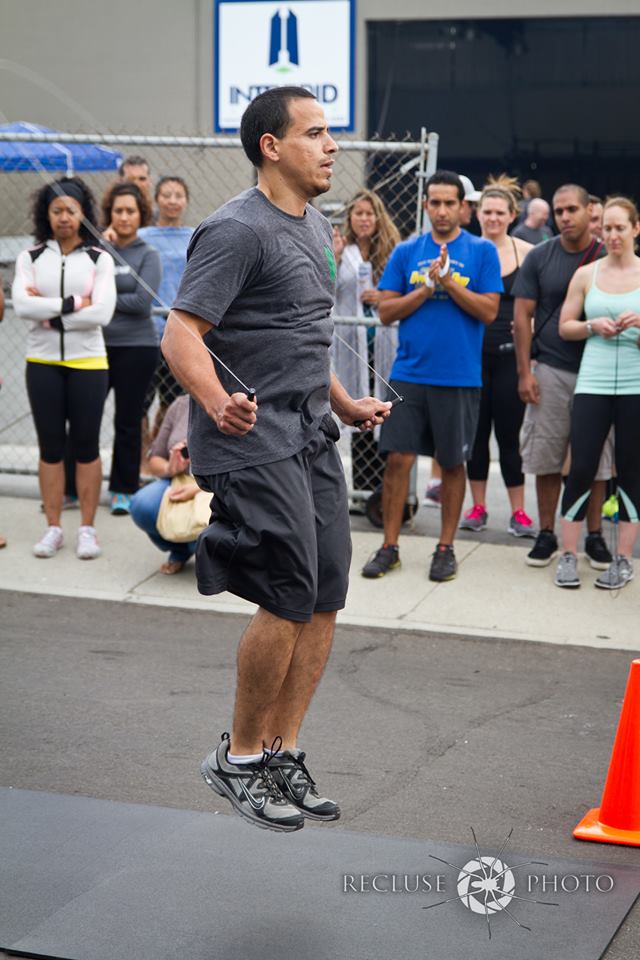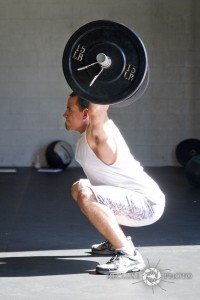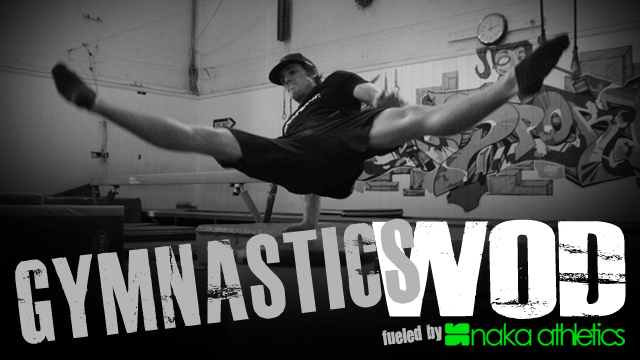26
Sep / 13
Jump Rope Clinic – Lessons Learned
Categories: Workout of the Day, Workshop
posted by: Holley
I’ve heard a lot of great success stories from the members who attended the clinic last week. I saw Nat, Sonia, Adriana, Tina and Pat put up big numbers for consecutive dubs the night of, and Scott C knocked out 20 dubs in a row during the competition. I’m sure I’m not remembering everyone’s success, so please post additional to comments.
What’s also great about the clinic is that I was able to watch the instructors and pick up some coaching pointers. I’d like to share what I learned with all of you so that when you’re practicing at home and maybe in front of a mirror, you can spot some common errors. Also, if you see a fellow classmate struggling with one of the below issues, you can help them out and politely point them out to them.
1. Rope is too long – This was a very common theme for everyone at the clinic, including yours truly. I used to think it was okay to be jumping with a long rope because even if your technique wasn’t great, you could probably get through a few dubs. However, it seems to be a hindrance for long term progress. Ropes that are too long can throw off your rhythm, require you to jump too high, require you to turn the rope with your arms and in general, trains inefficient form. You need very minimal clearance to get the rope over your head and under your feet. If you’re just trying to select a rope from the gym’s collection, the measurement method I posted about works pretty well, but if you buy your own rope, you’ll likely want to cut it down so it’s closer to your waistline.
2. Lack of rhythm – Finding your rhythm is very important to being successful with double unders, I have mentioned that many times in the past. Once you’ve gotten a couple of doubler unders, stringing them together is all about rhythm. The instructors discouraged the single, double, single, double approach because it teaches you the wrong rhythm. A drill that some of the attendees found to be successful, was to hold the jump rope in front of you without turning it and start jumping in a consistent rhythm. While you jump in the air, tap the handles of your rope together twice to represent your double under. This will help to teach your hands and feet to be coordinated, and to find your double under rhythm.
3. Hunching over and pike jumping – When some people attempt double unders, then tend to jerk their torsos forward and bend at the hips with straight legs (essentially doing a pike jump) to get over the rope. The best way to complete a double under is to keep the chest upright, shoulders relatively relaxed and to pick the feet up by bending at the knees and kicking your feet back. The more you can avoid the pike or tuck jump, the better.
4. Picking the toes up – This one is tied very closely to #3, it’s usually just a less severe form of piking. When you pick up your toes when you jump, one it wears out your shins, and two, the rope tends to get caught on your toes. When this happens, just think jump on the toes and try to bend at the knees and pull the feet back behind you.
5. Turning the rope with your arms – The part of the body that does all the work turning the rope is the wrist. Turning with the whole arm or even just your forearm is inefficient and not as quick as a flick of the wrists. People who do this often have a rope that’s too long or have an imbalance about which arm is doing the most work. Usually, it’s one side that’s turning efficiently, and the other side is either along for the ride or working to hard turning with the arm. The first problem is an easy fix, the second one will probably take time practicing in front of a mirror to get both sides to turn the rope the same way. For optimum form for most people, the elbows should be tucked in close to the body (usually the waist) and your hands should be slightly in front of your body.
If you avoid these common pitfalls, you should have pretty good form and be knocking out double unders like a champ. If you’ve practiced the wrong technique for a while, it’s hard to untrain those habits, so be patient with yourself as you practice. Here are a couple of more minor pointers:
6. Hold the entire handle of the jump rope, don’t just barely grip the ends, it gives you more control.
7. If you are suddenly doing a lot more jumping rope than normal, be sure to roll out your calves before and after, and likely the muscle just to the outside of your shin bone. This is especially important if you are prone to shin splints.
8. Once your dubs become more efficient, conserve energy and don’t jump as high. To be really fast like Shane who can do 164 dubs in a minute, you don’t really jump at all, just pick your feet up to get out of the way of the rope.
9. If you want to try out triples, the same rules apply with the dubs, you just need a little extra hang time so you’ll have to jump fairly high and kick those feet back. It’s a little harder on the calves and shins, so don’t over-do it.
Paralette jumps are no fun and waste a lot of energy, help your friends out and post any additional pointers you received to comments.
WOD 09.26.13
Mobility:
3 position hamstring stretch
Forearms
Skill:
Rope Climb


 310.465.6565 |
310.465.6565 |


























Leave a Comment:
RSS feed for comments
on this post.